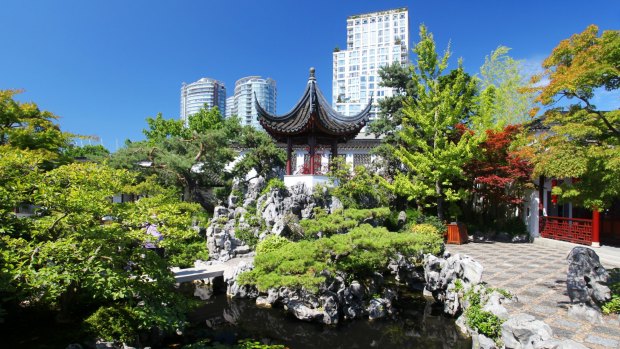
The Sun Yat-Sen Chinese Garden.Credit: Shutterstock
Stand at certain spots in Vancouver's Chinatown and you see three layers of history. Low, pastel-coloured shophouses with their strings of tatty paper lanterns provide the stereotype of old Chinatown. Compact office and bank buildings from a decade or two ago stand adjacent, flanked by stone lions. Behind are brand-new high-rise apartments, for some a troubling exclamation mark that signals the demise of a once-vibrant district.
I'm on a walkabout with Winston, a guide from Tours by Locals who quickly observes my particular interest in Chinatown and rearranges our plans accordingly. The well-informed Chinese-Canadian could hardly be a better guide, since his grandmother once lived in Chinatown, which formed an influential backdrop to his early life.
"When I was younger, you had to elbow your way along the sidewalk and you couldn't find parking anywhere. I had to drive around the block while my mother did the shopping," he recalls.
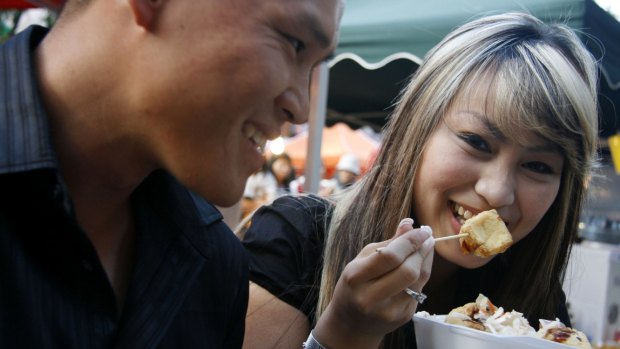
Visitors tuck into Chinatown street food.
His grandmother lived on Keefer Street, which has lingering old-time shops selling traditional medicines, slabs of pork and dumplings. We pop into Maxim's bakery for a coconut bun; the interior has slumbered in a time warp since the 1970s. Old ladies crack nuts outside, scattering shells on the footpath.
Such vignettes of the "real" Chinatown are becoming rare. The shopping crowds that Winston remembers have long gone. From the 1990s onwards, increasingly well-heeled immigrants from Hong Kong and later mainland China preferred the southern Vancouver suburb of Richmond, and Chinatown slid into decline. For 20 years it was a slowly rotting district of shuttered-up shops and tenement buildings.
"That all started to change in the late 2000s as revival seeped through from the adjacent, former industrial areas of Gastown and Railtown," says Winston. "People suddenly noticed the wealth of 19th and early 20th-century architecture, and realised that Chinatown's rents were very low despite the central location."
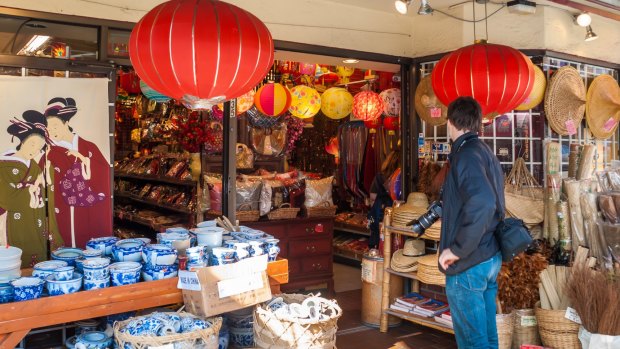
Inspecting the Chinatown shopping opportunities.Credit: Shutterstock
Clothes boutiques, artists' studios and entrepreneurial start-ups moved in. Bakeries opened, selling not old-fashioned coconut buns but pies with trendy fillings such as heirloom pumpkin or Japanese green-tea custard. Now cocktail bars and restaurants with innovative young owners lure people to Chinatown in the evening, giving it a more youthful, contemporary vibe. Many restaurants aren't Chinese or even Asian, such as the diminutive Oyster Express, Bestie for German street food, and bar-eatery Mamie Taylor's for finger-licking southern American comfort food, designed to accompany cocktails based on bourbon, tequila or Guatemalan rum.
"We couldn't have afforded this sort of space anywhere else," says Ron Oliver, co-owner of Mamie Taylor's, which opened three years ago in what was once a Chinese bakery. "The whole area was languishing and the shutters came down at six o'clock in the evening. I think Chinatown would be dead without new businesses."
The changes haven't been without controversy, however. Chinatown is one of the city's oldest neighbourhoods, first settled by immigrant gold miners and railway workers, and some consider that makes it a repository of important ethnic culture and character. As young, moneyed people move in, the ageing Chinese population, isolated by age and language barrier, loses its sense of neighbourhood and has access to fewer affordable businesses and services.
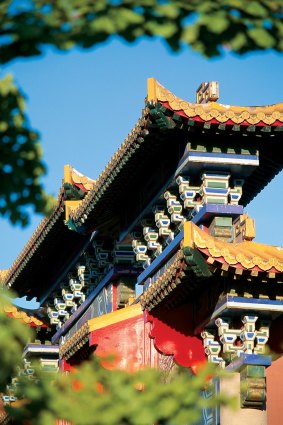
The Chinese Cultural Centre.Credit: Dannielle Hayes
"For many Chinese-Canadians, Chinatown is a symbol of early Chinese immigrant life and its struggle with discrimination. The community banded together in mutual support, particularly in providing housing for low-income residents through clan associations," says Winston.
The worry is that this history is being lost; that older, low-income residents are being pushed out by new high-rise developments; that Cantonese heritage and language is being usurped by the new wave of Mandarin speakers and the arrival in Chinatown of non-Chinese interlopers. But, as Winston acknowledges, an argument also runs that Chinatowns everywhere are a Qing Dynasty relic no longer relevant to contemporary Chinese immigrants.
"The optimists would also say that the new wave of businesses is better than empty storefronts, and the increased density brought about by high-rise apartments will help support local shops and restaurants."
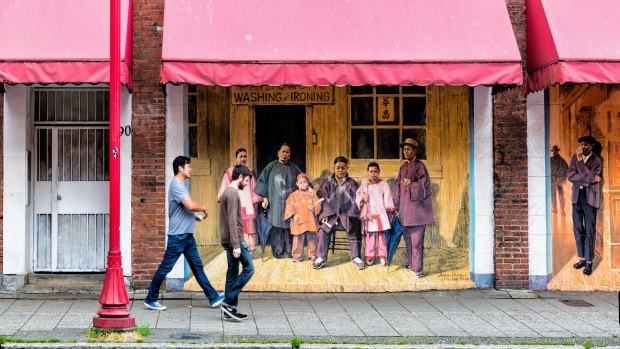
A historical mural on East Pender Street, Vancouver, depicting a Chinese laundry in 1884.Credit: Shutterstock
For visitors uninvolved in the sometimes passionate debate, a visit to Chinatown is a fascinating look at a neighbourhood in transition that offers a slice of two worlds. You can admire street murals depicting Chinatown's important ethnic history and traipse through Dr Sun Yat-Sen Classical Chinese Garden, with its clipped bonsai and latticed walkways. Some streets are wafted with the aromas of roast duck hanging from hooks and steamed buns in wicker baskets. Pyjama-clad retirees haggle over vegetables piled on trestles outside shops.
"There are still corners where I can bring my kids to show them how it all once was," says Winston. "But honestly, I don't even know anyone who comes to Chinatown to buy their vegetables any more. And nearly all the cheap, traditional restaurants frequented by students and blue-collar workers have gone. Even my old favourite Jade Dynasty has been revamped, and I suspect they're about to do away with the old dim-sum carts."
The flip side of the coin is that, instead of shrimp dumplings and chicken's feet, you can tuck into more varied, contemporary pan-Asian food in a new wave of trendy eateries. ("Not that we called them eateries when I was young," mourns Winston.) Upmarket Keefer Bar does Peking duck sliders and dim sum to accompany its cocktails. The Union has bar snacks such as endamame beans and gado-gado, plus a menu that runs through comfort foods such as dumplings, pho and pad Thai. Its walls are plastered with blow-up photography of Chinatown's gritty old facades.
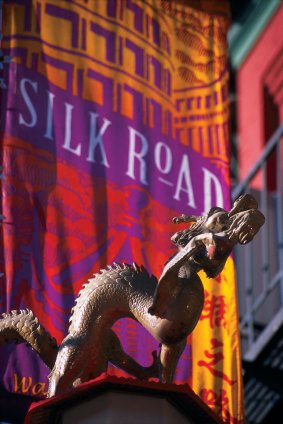
Here there be Chinese dragons.
Bao Bei Chinese Brasserie is marked by a retro neon sign once common in Chinatown in the 1970s. French-Japanese chef Joel Watanabe serves tapas-style dishes influenced by Vietnamese, Chinese and Taiwanese cuisines, but hasn't abandoned traditional dishes such as sticky rice cakes, steamed buns and pot stickers. Meanwhile relative newcomer Torafuku has made a name for inventive, big-flavour Asian-fusion dishes inspired by Japan, Korea, Taiwan and Vietnam, such as pork ribs with a spicy cucumber salad, oxtail in Shaoxing wine, or braised duck ramen noodles. It's crammed with youthful Vancouverites, some accompanied by Chinese-immigrant grandparents bemused by this brave new world of taste.
"Sometimes I think Chinatown these days is neither about the old nor the new Chinese. Soon it won't be an ethnic district at all any more. It's an area struggling with its identity. I don't know how this is all going to work out," says Winston, who seems ambivalent about its changes.
It's certainly an evolving neighbourhood, and still edgy. For the moment, parts of Chinatown remain shabby and encamped by homeless people. Fantastic Victorian-era buildings on the corner of Hastings and Main streets have scarcely been touched in a half-century and are almost squalid. Yet the 1889 Italianate-style Wing Sang building, Chinatown's oldest building, now houses a real-estate agency and contemporary art gallery.
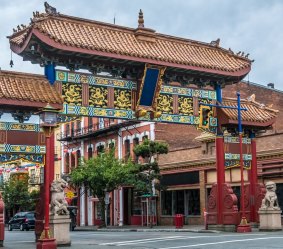
The grand entrance.Credit: Shutterstock
Winston walks me down East Pender Street, where the new wave of improvements is obvious. Some facades have had a facelift, and offices have moved in. The old Chinatown appearance and colour scheme is nicely preserved, but the look is tidier and smarter. Bootleg Barbers sells bamboo furniture and coffee along with its hipster haircuts, but unpretentious Chinese groceries nearby remain piled with bok choy and carrots.
On Union Street we pass Crackle Creme, which Winston describes as a cafe for white females who like everything wholesome and organic. ("My Danish wife loves it.") Yet just along the street, after my tour, I find a bargain-priced noodle shop serving old-time noodles swimming in garlic and ginger and rich beef flavours. It's a taste of old Chinatown, though perhaps not for much longer.
TRIP NOTES
MORE
FLY
Air Canada flies direct to Vancouver daily from Sydney (14 hours) with domestic connections from Melbourne. Phone 1300 655 767, see aircanada.com
STAY
The Burrard is a funky, revamped 1950s motor inn with considerable retro style, friendly staff and complimentary bicycles. Phone +1 604 681 2331, see theburrard.com
Luxury Metropolitan Hotel is a 15-minute walk from Chinatown; its restaurant Diva serves excellent regional food and offers 500 wines. Phone +1 604 687 1122, see metropolitan.com
DO
Vancouver-based Tours by Locals operates private guided tours in 157 countries and has nine guides in Vancouver, including Winston. His four-hour "UnDowntown" our costs $388 for four people and is very flexible in focus, based on customer interests. See toursbylocals.com
Brian Johnston was a guest of Destination British Columbia, Tourism Vancouver and Tours by Locals.
Sign up for the Traveller Deals newsletter
Get exclusive travel deals delivered straight to your inbox. Sign up now.